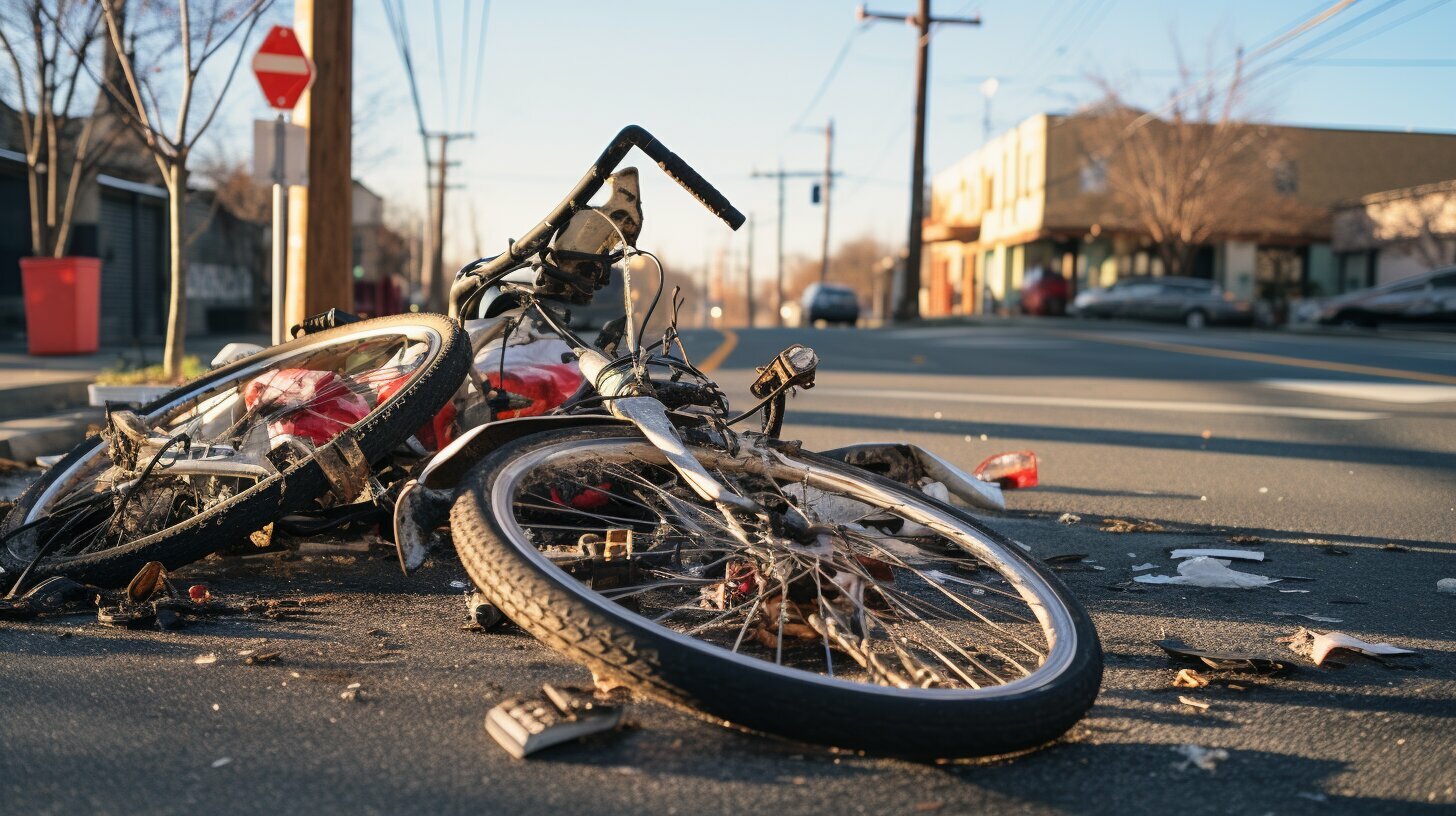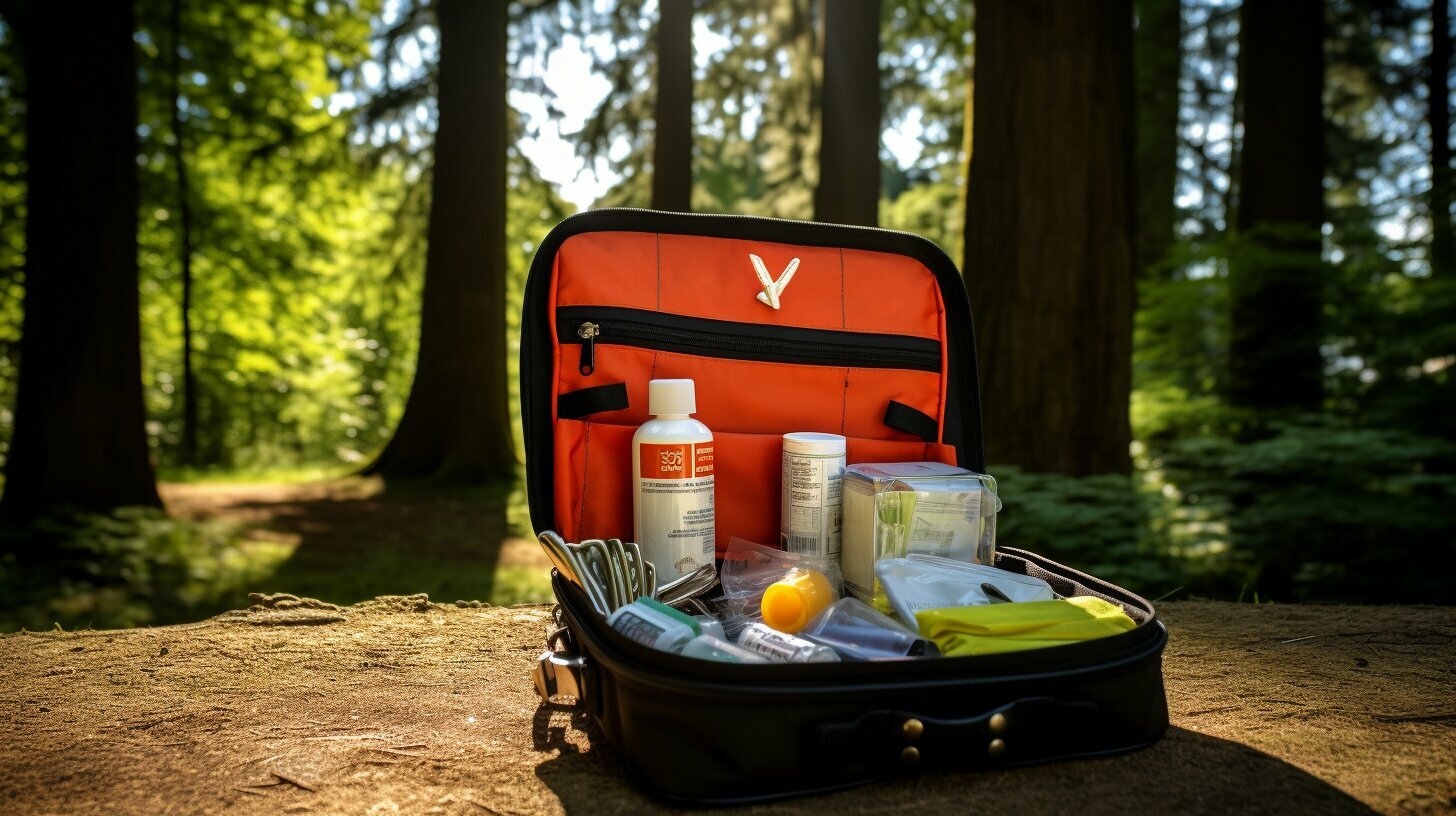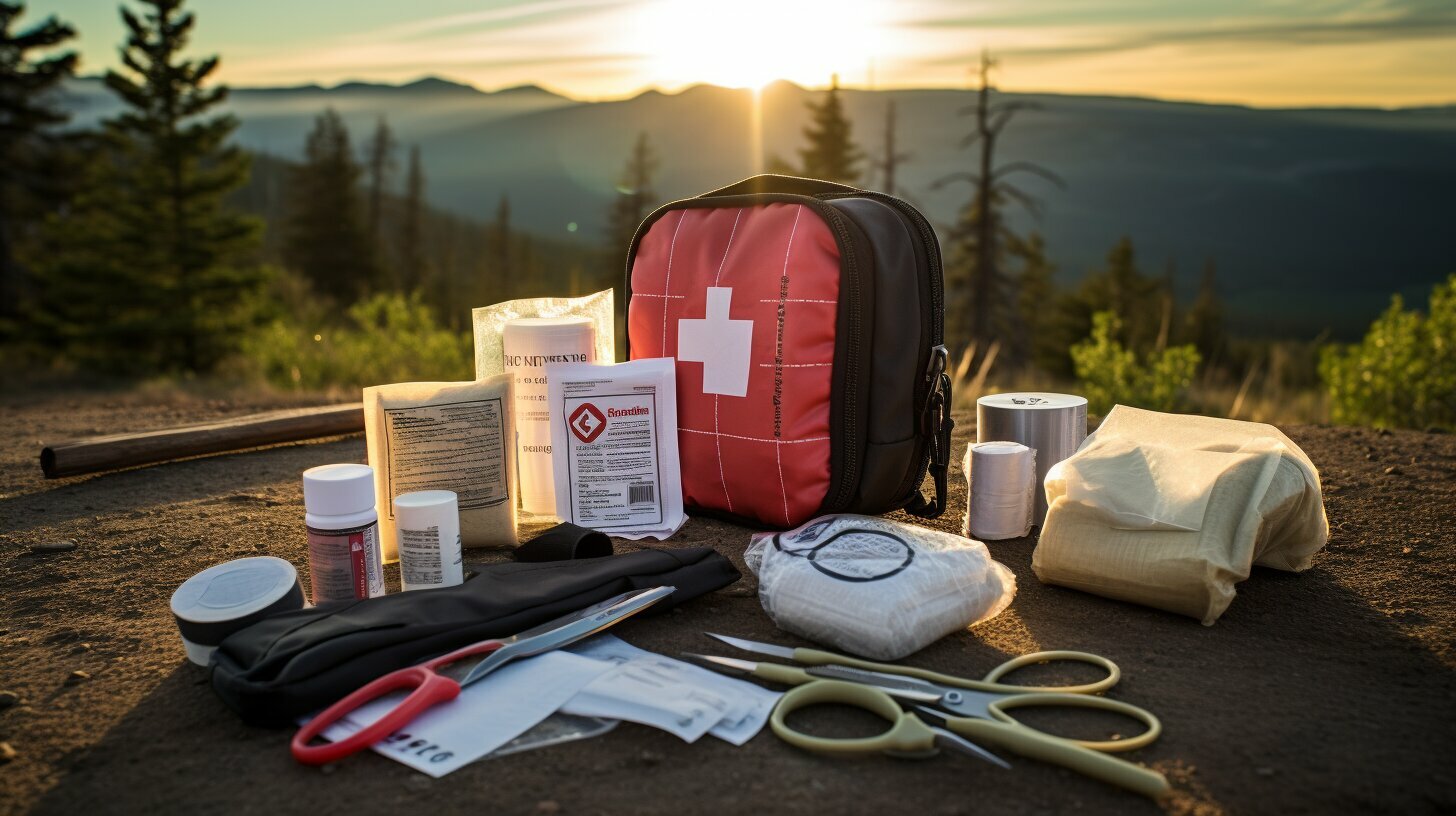When cycling, accidents can happen, so it’s important for cyclists to be prepared with a first aid kit. The safety of cyclists should always be a top priority, and having the right tools to address injuries is crucial. From cuts and abrasions to musculoskeletal issues, being equipped with the essential first aid supplies can make a significant difference in ensuring the well-being of cyclists on the road.
A basic first aid kit for cyclists should include a range of items to address common cycling injuries. Waterproof plasters of different sizes help protect cuts and wounds, while dressings provide additional coverage and support. Antiseptic wipes are essential for cleaning wounds to prevent infection, and bandages and surgical tape help secure dressings in place. Safety pins are handy for securing bandages or clothing during emergencies.
In addition to these essentials, there are other items that should be included in a cyclist’s first aid kit. Sunscreen is essential to protect the skin from harmful UV rays during long rides. Sterile wash is crucial for cleaning eyes and deep wounds effectively. Insect repellent helps keep pesky bugs at bay, while tweezers prove helpful for removing stingers or splinters. A lightweight foil blanket serves as a valuable emergency item, providing warmth and protection. A portable charger ensures that cyclists can stay connected in case of emergencies. Hand sanitizer, surgical gloves, small scissors, and a small waterproof bag help maintain hygiene and keep the first aid supplies organized.
While having a well-stocked first aid kit is crucial, it’s equally important for cyclists to know how to use the items effectively. Consider taking a first aid course to learn essential skills such as CPR and utilizing an AED/defibrillator. However, as a first aider, it’s important to note that pain relief medications such as ibuprofen and paracetamol should be available, but it’s best to avoid recommending or administering them. Pain relief should be left to healthcare professionals.
The type and size of the first aid kit will depend on the type of cycling being done and the level of remoteness. Cyclists should assess their needs and select a kit that caters to their specific requirements. Regardless of whether cycling alone or in a group, it’s crucial for cyclists to take responsibility for their own health and safety. Being prepared with a first aid kit can provide peace of mind and ensure that cyclists are equipped to handle any unforeseen situations on their journey.
Common Injuries and Basic First Aid Supplies for Cyclists
The most common injuries for cyclists are cuts, abrasions, bruises, and musculoskeletal issues. When accidents happen on the road or trail, it’s crucial for cyclists to be prepared with a well-stocked first aid kit. Having the right supplies on hand can make a significant difference in treating injuries promptly and effectively.
For basic first aid needs, a cyclist’s first aid kit should include essential items such as waterproof plasters of different sizes, dressings, antiseptic wipes, bandages, surgical tape, and safety pins. These items are essential for managing cuts, abrasions, and larger wounds. They help protect the injury from dirt, bacteria, and further damage, promoting faster healing.
Aside from the basic supplies, it’s also important to consider other potential hazards while cycling. Sunscreen is essential to protect the skin from harmful UV rays during long rides. Sterile wash is crucial for cleaning wounds and eyes in case of accidents. Insect repellent helps ward off pesky bugs that can cause irritation or transmit diseases. Tweezers are handy for removing stingers or splinters, while a lightweight foil blanket provides warmth during emergencies. Additionally, having a portable charger, hand sanitizer, surgical gloves, small scissors, and a small waterproof bag to store everything can be invaluable during longer trips.
Taking a First Aid Course and Additional Considerations
Knowing how to use the items in a first aid kit is just as important as having them. Cyclists are encouraged to consider taking a first aid course to gain knowledge in CPR and the use of an AED/defibrillator. These skills can be life-saving in critical situations.
While it’s recommended to have pain relief medications, such as ibuprofen and paracetamol, available in the first aid kit, it’s crucial to remember that as a first aider, it is best to avoid recommending or administering pain relief. Instead, focus on providing comfort, reassurance, and promptly seeking professional medical assistance if needed.
The size and contents of a cyclist’s first aid kit may vary depending on the type of cycling and level of remoteness. It’s always best to be prepared and take responsibility for one’s own health and safety, even when cycling in a group. By being equipped with the right supplies and knowledge, cyclists can confidently navigate bike accidents and ensure their well-being on the road.

| Essential First Aid Kit Items for Cyclists | Additional First Aid Kit Supplies for Cyclists |
|---|---|
| Waterproof Plasters | Sunscreen |
| Dressings | Sterile Wash |
| Antiseptic Wipes | Insect Repellent |
| Bandages | Tweezers |
| Surgical Tape | Lightweight Foil Blanket |
| Safety Pins |
Essential First Aid Kit Items for Cyclists
A basic first aid kit for cyclists should include waterproof plasters of different sizes, dressings, antiseptic wipes, bandages, surgical tape, and safety pins. These items are essential for addressing common injuries that cyclists may encounter during their rides.
Waterproof plasters are crucial for protecting cuts and abrasions from dirt and water, allowing the wounds to heal properly. Dressings are necessary to cover larger wounds and provide an additional layer of protection. Antiseptic wipes help clean the area around the injury to prevent infection, while bandages help secure dressings and provide support to strained or sprained joints.
Surgical tape is essential for securing dressings and can also be used to immobilize injured areas. Safety pins are useful for fastening bandages or securing improvised splints in case of fractures or dislocations.
Table 1: Essential First Aid Kit Items for Cyclists
| Item | Description |
|---|---|
| Waterproof Plasters | Various sizes for different types of injuries |
| Dressings | To cover and protect larger wounds |
| Antiseptic Wipes | To clean the area around the injury |
| Bandages | To secure dressings and provide support |
| Surgical Tape | To secure dressings and immobilize injured areas |
| Safety Pins | For fastening bandages or securing improvised splints |
It’s important to note that the size and contents of a first aid kit can vary depending on the type of cycling and the level of remoteness. For longer rides or mountain biking in remote areas, additional items such as a tourniquet, emergency whistle, or a SAM splint may be necessary.
Remember, having a well-stocked first aid kit is essential, but knowing how to use the items in it is equally important. Consider taking a first aid course to learn basic first aid skills, including CPR and how to use an AED/defibrillator. By being prepared and taking responsibility for your own health and safety, you can ride confidently knowing that you’re ready to handle any minor injuries that may occur.

Additional First Aid Kit Supplies for Cyclists
In addition to the basic supplies, cyclists should bring sunscreen, sterile wash for cleaning eyes and wounds, insect repellent, tweezers for removing stingers or splinters, and a lightweight foil blanket for emergencies. These additional items can help address specific needs that cyclists may encounter during their rides.
Sunscreen
Protecting the skin from harmful UV rays is essential for cyclists, especially during long rides under the sun. Applying sunscreen with a high SPF can help prevent sunburn and reduce the risk of skin cancer. Remember to reapply sunscreen regularly, especially if you’re sweating profusely.
Sterile Wash
When accidents happen, it’s important to clean wounds properly to prevent infections. Having a sterile wash designed specifically for cleaning eyes and wounds can help remove dirt, debris, and bacteria effectively, minimizing the risk of complications.
Insect Repellent
When cycling through areas with insects, it’s essential to protect yourself from bites that can lead to irritation and potential infections. Carry an insect repellent to keep mosquitoes, ticks, and other pests at bay.
Tweezers
Being able to remove stingers or splinters quickly and safely is important for cyclists. Tweezers provide precision grip, allowing you to remove foreign objects embedded in your skin with ease. Make sure to clean the tweezers with an antiseptic wipe before and after use.
Lightweight Foil Blanket
In emergency situations, such as accidents or sudden changes in weather conditions, a lightweight foil blanket can provide warmth and protection against the elements. Compact and easy to carry, it should be an essential item in every cyclist’s first aid kit.
| Item | Purpose |
|---|---|
| Sunscreen | Protection against harmful UV rays |
| Sterile Wash | Effective cleaning of eyes and wounds |
| Insect Repellent | Prevention of insect bites |
| Tweezers | Removal of stingers or splinters |
| Lightweight Foil Blanket | Emergency warmth and protection |
By including these additional supplies in their first aid kit, cyclists can better address specific needs and potential challenges they may encounter on their rides. Remember, the type and size of the first aid kit will depend on the type of cycling being done and the level of remoteness. It’s always best to be prepared and take responsibility for one’s own health and safety, even if cycling in a group.
Additional Considerations and First Aid Training for Cyclists
It’s important for cyclists to know how to use the items in their first aid kit and consider taking a first aid course to learn CPR and how to use an AED/defibrillator. Accidents can happen while cycling, and being prepared with the right knowledge and skills can make a significant difference in an emergency situation.
When assembling a first aid kit for cycling, there are a few additional items to consider. A portable charger for your mobile phone is essential, as it allows you to call for help in case of an emergency. Hand sanitizer is also important for maintaining hygiene, especially when dealing with open wounds. Surgical gloves should be included to protect both the first aider and the injured person from any potential infection.
In addition, small scissors are useful for cutting tape, clothing, or bandages, while a small waterproof bag keeps all the first aid items protected from moisture. These items provide practicality and convenience when attending to injuries on the go.
While having a well-stocked first aid kit is crucial, it’s equally important to know how and when to use the supplies. Consider taking a first aid course to gain the necessary skills and confidence to provide effective assistance during an emergency. First aid courses cover topics such as CPR and the use of an AED/defibrillator, which can potentially save a life. By learning these skills, cyclists can enhance their ability to provide immediate care and reduce the risks associated with cycling injuries.
Lastly, it’s worth mentioning that including pain relief medications like ibuprofen and paracetamol in your first aid kit can be helpful. However, it is essential to note that as a first aider, it is not recommended to recommend or administer pain relief without proper medical advice. The type and size of the first aid kit may vary depending on the type of cycling and the remoteness of the location. Regardless of the circumstances, prioritizing one’s own health and safety is paramount, even when cycling as part of a group.
